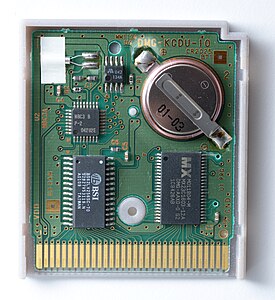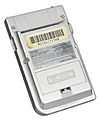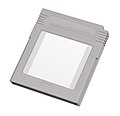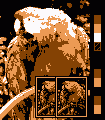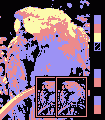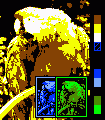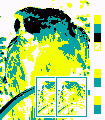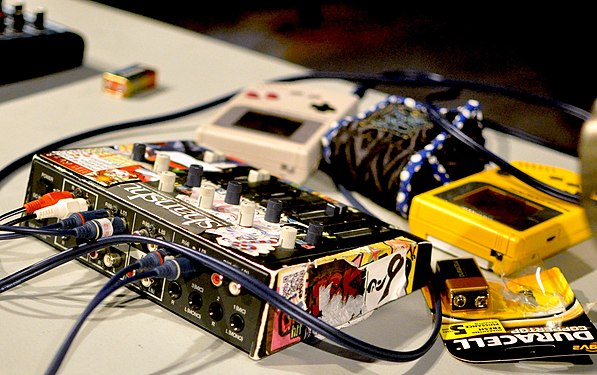History of video games/Platforms/Game Boy
-
A GameBoy at the Nintendo World Store.
History
[edit | edit source]Development
[edit | edit source]Nintendo had previously made dedicated handheld consoles such as the Game & Watch series consoles as well as the Nintendo Computer Mah-Jong Yakuman, however the Game Boy would be their first handheld to play interchangeable cartridges
Launch
[edit | edit source]The GameBoy was released in 1989 on April 21st in Japan and July 31st in the United States of America.[1]
Project Atlantis
[edit | edit source]Project Atlantis was a canceled Game Boy successor that used a 32 bit ARM 7 CPU that was in development by 1995.[2] The system was canceled due to it's enormous size, high expense, and poor performance.[2][3]
GameBoy Color
[edit | edit source]The GameBoy Color was released on November 18th, 1998.[1]
A touch screen adapter for the GameBoy Color was developed, but never released.[3]
Third party support for the system was large, with even a sewing machine supporting control over Game Boy link cable.[4]
In 2001 the Mobile System GB released in Japan for 5800 yen.[5] Though it allowed a Game Boy to connect to cell phones to access the internet on the go, it had a number of fees associated with using it, and sold under 100,000 units.[5]
Legacy
[edit | edit source]In 2003 the original GameBoy was discontinued,[6] having been succeeded by the Game Boy Advance line of consoles. The GameBoy and the GameBoy Color sold 118.69 million units collectively.[7][8]
GameBoy emulation has proven to be a fairly common topic in programming education.[9] [10] In 2020 researchers made the Engage an unofficial ultra low power GameBoy hardware clone which required no battery power to operate, instead being powered by solar energy and energy captured from button presses.[11]
The Game Boy became would later become a popular musical instrument for Chiptune music creation.[12][13]
Technology
[edit | edit source]In terms of technical capabilities, the Game Boy is often thought of as a portable Nintendo Entertainment System, though the internal architectures of these systems are radically different.
Original GameBoy
[edit | edit source]Compute
[edit | edit source]
The GameBoy uses a 8 bit Z80 CPU clocked at 4.194304 megahertz.[14][7][15]
The GameBoy has eight kilobytes of RAM and eight kilobytes of VRAM.[16]
Display
[edit | edit source]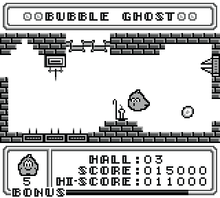
The GameBoy has a 160 by 144 resolution LCD.[14] The dot matrix display could display four shades from green to grey, making it monochrome.[17]
Audio
[edit | edit source]The GameBoy has four channels of stereo sound.[7] The system only had a single built in speaker, restricting the system to monophonic audio by default and requiring headphones for full stereo audio output.[18]
Networking
[edit | edit source]The GameBoy has a link cable port.[14]
Power
[edit | edit source]The original GameBoy uses four AA batteries and draws 70 to 80 mAh an hour, lasting about 30 hours.[14]
GameBoy Color
[edit | edit source]The GameBoy color possessed significantly increased specs compared to the original monochrome models.
Compute
[edit | edit source]An 8-bit Z80 based CPU clocked at 8.388 megahertz powers the GameBoy Color.[14][15]
The GameBoy color has 32 Kilobytes of RAM.[14]
Display
[edit | edit source]The GameBoy color uses a color TFT LCD, with a resolution of 160 by 144 pixels, 32,000 colors displayable, and 56 simultaneous colors.[14]
Networking
[edit | edit source]A link cable port and inferred port are present.[14]
Power
[edit | edit source]The GameBoy color takes two AA batteries, and draws 70 to 80 mAh an hour, lasting for about 10 hours of runtime.[14]
Accessories
[edit | edit source]Some Suzuki and Aprillia motorcycles are designed to hook up to a Game Boy Color through a special cable and cartridge combination for diagnostics access.[19]
A work oriented accessory, the WorkBoy keyboard and cartridge combo was planned but not released.[20]
Notable Games
[edit | edit source]1989
[edit | edit source]
Tetris
[edit | edit source]The rights to Tetris proved to be a contentious issue between those who claimed rights and the Soviet government.[21]
Read more about Tetris on Wikipedia.
1991
[edit | edit source]1992
[edit | edit source]- Super Mario Land 2: 6 Golden Coins
- Kirby's Dream Land - The first Kirby game
- X - Early 3D Game on the GameBoy
1993
[edit | edit source]1994
[edit | edit source]1996
[edit | edit source]Pokemon Red and Blue
[edit | edit source]The first Pokemon games were inspired by series creator Satoshi Tajiri's experience catching bugs as a youth in Machida, Japan.[22][23]
At the last minute an additional Pokemon was added by the development team to make the total number of monsters catchable 151.[24] This addition caused a number of urban legends and myths regarding an in game truck.[24]
The spooky ambiance of the in game location Lavender Town sparked a number of urban legends and myths.[25]
-
A short documentary on Satoshi Tajiri and the creation of Pokemon by YouTube channel Video Game Story Time.
-
The Kanto region in pokemon loosely corresponds to the Kantō region in Japan.
-
A natural area in the now urbanized Machida, Japan. Natural areas similar to this served as the inspiration for the Pokemon games.
1997
[edit | edit source]1998
[edit | edit source]1999
[edit | edit source]Mario Golf
[edit | edit source]Mario Golf for the GBA mixed golf mechanics with a simple RPG, sparking a small genre of golf RPGs.[26]
Read more about Mario Golf on Wikipedia.
Pokémon Gold and Silver
[edit | edit source]Then HAL Laboratory President Satoru Iwata was brought on to help with making compression tools for game graphics.[27]
Read more about Pokémon Gold and Silver on Wikipedia.
-
A short documentary on Satoru Iwata's involvement in Pokemon by YouTube channel Video Game Story Time.
-
The Hōryū-ji. In game locations were inspired by the Kansai region in Japan.[28]
-
Pokemon Silver cartridge board. Note the coin cell battery.
2000
[edit | edit source]Metal Gear Solid Ghost Babel
[edit | edit source]The track "Ascent" is a particularly impressive piece of chiptune. Read more about Metal Gear Solid Ghost Babel on Wikipedia.
2001
[edit | edit source]2002
[edit | edit source]Special edition GameBoys
[edit | edit source]- Yellow Tommy Hilfiger Game Boy Color.[29]
Gallery
[edit | edit source]Original GameBoy
[edit | edit source]GameBoy Pocket
[edit | edit source]GameBoy Light
[edit | edit source]GameBoy Color
[edit | edit source]GameBoy Accessories
[edit | edit source]Game Genie
[edit | edit source]-
A Game Genie for the Game Boy
-
A Game Genie attached to a Game Boy.
GameBoy Internals
[edit | edit source]Color palettes
[edit | edit source]-
Simulated colors of the original Game Boy.
-
Simulated colors of the Game Boy Pocket.
-
Simulated colors of the Game Boy Color.
-
One of the color palettes used by the Game Boy Color when using an monochrome original Game Boy cartridges.
-
One of the color palettes used by the Game Boy Color when using an monochrome original Game Boy cartridges.
-
One of the color palettes used by the Game Boy Color when using an monochrome original Game Boy cartridges.
-
One of the color palettes used by the Game Boy Color when using an monochrome original Game Boy cartridges.
-
One of the color palettes used by the Game Boy Color when using an monochrome original Game Boy cartridges.
-
One of the color palettes used by the Game Boy Color when using an monochrome original Game Boy cartridges.
-
One of the color palettes used by the Game Boy Color when using an monochrome original Game Boy cartridges.
-
One of the color palettes used by the Game Boy Color when using an monochrome original Game Boy cartridges.
-
One of the color palettes used by the Game Boy Color when using an monochrome original Game Boy cartridges.
-
One of the color palettes used by the Game Boy Color when using an monochrome original Game Boy cartridges.
-
One of the color palettes used by the Game Boy Color when using an monochrome original Game Boy cartridges.
-
One of the color palettes used by the Game Boy Color when using an monochrome original Game Boy cartridges.
Marketing
[edit | edit source]-
Game Boy logotype.
-
Game Boy Pocket logotype.
-
Game Boy Light logotype.
-
Game Boy Color logotype.
Other
[edit | edit source]-
A GameBoy perpetually playing Tetris at the Nintendo World Store, having survived bombing during the Gulf War.
-
A Japanese Warranty included with a Game Boy.
-
Prototype Lemmings cartridge
-
Then first lady Hillary Clinton, plays a GameBoy on a flight in 1993.
-
The audio characteristics of the Game Boy would later be widely used by the Chiptune community, shown here.
-
The Ultimate Game Boy talk at CCC.
External Resources
[edit | edit source]Archived web materials
[edit | edit source]References
[edit | edit source]| Parts of this page are based on materials from: Wikipedia: the free encyclopedia. |
- ↑ a b "25 years of the Game Boy: A timeline of the systems, accessories, and games". VentureBeat. 21 April 2014. https://venturebeat.com/2014/04/21/25-years-of-the-game-boy-a-timeline-of-the-systems-accessories-and-games/. Retrieved 23 October 2020.
- ↑ a b "GDC: Nintendo's Unreleased Portable Prototypes" (in en-us). Wired. https://www.wired.com/2009/03/gdc-nintendos-u/. Retrieved 26 October 2020.
- ↑ a b "A look into Nintendo's unreleased Game Boy successor" (in en). Nintendo Everything. 17 April 2016. https://nintendoeverything.com/a-look-into-nintendos-unreleased-game-boy-successor/. Retrieved 26 October 2020.
- ↑ "There Really Was A Sewing Machine Controlled By A Game Boy". Hackaday. 12 March 2020. https://hackaday.com/2020/03/11/there-really-was-a-sewing-machine-controlled-by-a-game-boy/. Retrieved 25 October 2020.
- ↑ a b "That Time Nintendo Took the Game Boy (and Pokémon) Online" (in en-us). Kotaku. https://kotaku.com/that-time-nintendo-took-the-game-boy-and-pokemon-onli-1836423946. Retrieved 26 October 2020.
- ↑ Sun, Leo (30 April 2014). "Nintendo's Game Boy Turns 25 -- A Look Back at the Business of 'Withered Technology'". The Motley Fool. Retrieved 11 December 2020.
- ↑ a b c "Game Boy". Smithsonian Institution. Retrieved 24 October 2020.
- ↑ "IR Information : Sales Data - Dedicated Video Game Sales Units". Nintendo Co., Ltd. Retrieved 14 November 2020.
- ↑ "Why did I spend 1.5 months creating a Gameboy emulator? · tomek's blog". blog.rekawek.eu. Retrieved 11 December 2020.
- ↑ "Introduction - DMG-01: How to Emulate a Game Boy". blog.ryanlevick.com. Retrieved 11 December 2020.
- ↑ "The first battery-free Game Boy wants to power a gaming revolution". CNET. Retrieved 11 December 2020.
- ↑ "Chiptunes: Making Music with a Nintendo Game Boy The Library". library.berklee.edu. Retrieved 14 December 2020.
- ↑ "Make Chiptunes with a Gameboy | Open Music Initiative". omi.yale.edu. Retrieved 14 December 2020.
- ↑ a b c d e f g h i "Technical data". Nintendo of Europe GmbH. Retrieved 23 October 2020.
- ↑ a b "Everything You Always Wanted To Know About GAMEBOY". Retrieved 13 December 2020.
- ↑ "Game Boy Teardown". iFixit. 21 April 2019. Retrieved 29 October 2020.
- ↑ "Thirty Years Ago, Game Boy Changed the Way America Played Video Games". Smithsonian Magazine. Retrieved 23 October 2020.
- ↑ "What is the meaning of the 'dot matrix with stereo sound' that is written on the Game Boy game console? - Quora". www.quora.com. https://www.quora.com/What-is-the-meaning-of-the-dot-matrix-with-stereo-sound-that-is-written-on-the-Game-Boy-game-console.
- ↑ "The GameBoy Motorcycle Accessory - What?". Retrieved 29 November 2020.
- ↑ "Lost Gameboy Peripheral WorkBoy Found After 28 Years" (in en). TechRaptor. https://techraptor.net/gaming/news/lost-gameboy-peripheral-workboy-found-after-28-years.
- ↑ "Tetris: how we made the addictive computer game" (in en). the Guardian. 2 June 2014. https://www.theguardian.com/culture/2014/jun/02/how-we-made-tetris.
- ↑ Lopez, German (13 July 2016). "Pokémon Go’s surprising roots: bug catching" (in en). Vox. https://www.vox.com/2016/7/13/12172826/pokemon-go-android-ios-bug-catching.
- ↑ "The Origins Of Pokémon". Kotaku. Retrieved 12 December 2020.
- ↑ a b "That Time Some Players Thought Mew Was Under A Truck In Pokémon" (in en-us). Kotaku. https://kotaku.com/that-time-some-players-thought-mew-was-under-a-truck-in-1792716938. Retrieved 27 October 2020.
- ↑ "Pokémon's Creepy Lavender Town Myth, Explained". Kotaku. Retrieved 30 October 2020.
- ↑ "Here's the launch trailer for Golf Story on Switch, the Game Boy Color Mario Golf follow-up we've wanted for 18 years". VG247. 28 September 2017. Retrieved 30 October 2020.
- ↑ "Iwata Asks". iwataasks.nintendo.com. Retrieved 25 October 2020.
- ↑ Famularo, Jessica. "Pokemon's Ties to the Real World". Inverse. Retrieved 13 December 2020.
- ↑ "Looking Back At Some Of The Weirder Limited Edition Consoles" (in en-us). Kotaku. https://kotaku.com/looking-back-at-some-of-the-weirdest-limited-edition-co-1818480546.



![The Hōryū-ji. In game locations were inspired by the Kansai region in Japan.[28]](http://upload.wikimedia.org/wikipedia/commons/thumb/c/c3/Buddhist_Monuments_in_the_Horyu-ji_Area-122502.jpg/225px-Buddhist_Monuments_in_the_Horyu-ji_Area-122502.jpg)
